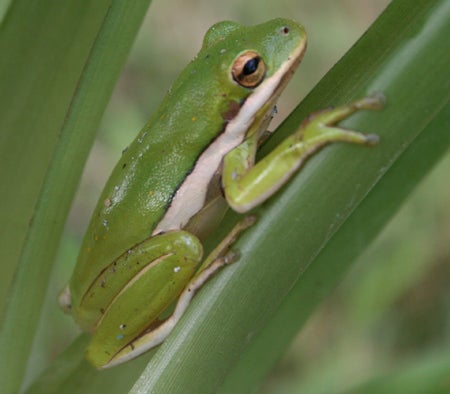SCIENTIFIC NAME:
Hyla cinerea
OTHER NAMES:
“Rain frog,” due to the fact that it mostly calls during damp weather and the “cowbell frog,” because from a distance, calls sometimes sound bell-like.
STATUS:
Common nearly statewide, but rare or absent from portions of Interior Plateau and northern portions of Southwestern Appalachians, Ridge and Valley, and Piedmont. Lowest Conservation Concern.
DESCRIPTION:
The green treefrog is a rather large, but slender treefrog. It obtains a maximum length of approximately 2.5 inches. The skin on the back is smooth and typically bright green, but can vary from a yellowish to a dull greenish gray. A prominent white or cream colored stripe extends from the mouth along the sides of the body, usually extending to just above the thigh. The length of this stripe varies, and in some populations is absent altogether. There may be small yellow spots on the back. The belly color is light cream to green. They have large adhesive disks on the end of each toe. Males have wrinkled throats, indicating the vocal pouch, and are slightly smaller than females.
DISTRIBUTION:
Green treefrogs live primarily in the southeastern United States, from Delaware, south through eastern Maryland, Virginia, and the Carolinas, southern Georgia, across all of Florida, west to eastern Texas and areas north along the Mississippi Valley to southern Illinois. In Alabama their distribution is essentially statewide.
HABITAT:
Green treefrogs prefer wet or moist areas such as swamps, lake sides and the edges of streams. Occasionally they are found in brackish water. During the day they are often found on vegetation near water or in other moist shady areas sitting quietly with their feet folded neatly beneath them. Prefer to breed in permanent aquatic habitats with emergent vegetation.
LIFE HISTORY AND ECOLOGY:
Breeding in Alabama usually begins in April and extends into August. Green treefrogs tend to congregate in extremely large groups. At night, males begin calling just before dark. The male’s call is a harsh, nasal “quank-quank-quank . . .” repeated about once per second. From a distance, these calls sometimes sound bell-like, which accounts for the local name “cowbell frog.” Females are attracted to the male’s location in a swamp, pond, or other water source where they deposit their eggs, 10 to 20 at a time in a jelly like envelope that is attached to floating or submerged vegetation. Females may lay up to 400 eggs. Fertilization takes place externally. Calling and egg-laying are particularly frequent after rainstorms. Larvae hatch in about a week, with tadpoles metamorphosing into adults 55 to 63 days after hatching.
Adults are opportunistic feeders, eating a variety of insects and small arthropods. They are often seen on houses around windows or exterior lights searching for insects. Tadpoles feed on algae.
REFERENCES:
Davidson College, Herpetology Laboratory. Frogs and Toads of North Carolina (online). “Green Treefrog – Hyla cinerea.”
Georgia Wildlife Web, Information provided by The Georgia Museum of Natural History and Georgia Department of Natural Resources (On line). ‘Frogs – Green Treefrog, Hyla cinerea.”
Mount, R. H., 1975. The Reptiles and Amphibians of Alabama. Ala. Agri. Expt. Sta., Auburn Univ., Auburn, AL. 347 pp.
Texas Memorial Museum, University of Texas, Austin. Herps of Texas – Frogs and Toads (On line). “Hyla cinerea–Green Treefrog.”
AUTHOR:
Ron Eakes, Wildlife Biologist, Alabama Division of Wildlife and Freshwater Fisheries







